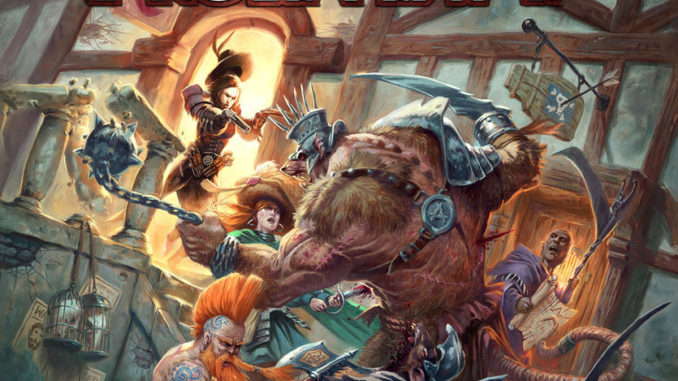
Previously we explored the gritty nature of the inevitable hack ‘n slash nature of Combat. The wounds described there are the everyday nicks, bruises and battering of everyday life, but what about the ongoing effects of that festering wound?
Wounds, Criticals and Death!
The wounds mechanic hasn’t changed and I covered it in the combat article, but to recap; once your attacker has determined the amount of damage they inflict, you reduce that by your toughness bonus and armour, and what is left is the number of Wounds you take. Exactly the same as 1st and 2nd Edition.
Critical Wounds (previously Critical Hits) is also familiar. Only now you can inflict one if you roll a Critical Success (a double on the dice on a successful attack). You also suffer one when you lose more Wounds than you have (which was how it was in the earlier versions). Unlike the preceding editions, the table you roll on is not determined by your original hit location. You need to determine that again, which is an odd rule that seems to serve no purpose without looking deep into the mathematical probabilities of hit locations (and really, who wants to do that?) Critical Wounds also come with some additional normal wounds on top, since you can suffer a Critical before you reach zero wounds. This also means you could be taking a Critical from a hit, and then taking another because the first one put your over your Wounds limit. (Ouch!) Similar to the earlier editions the lower results, while problematic, are not all that worrisome. But as you move up the table they get worse, the top result being the end of your miserable existence, and freedom from this life of pain. At least, you hope so.
Fourth Edition goes into more depth that its older incarnations, with details on broken bones, torn muscles and amputated parts, in various levels of severity. A Minor broken bone for example imposes some negative modifiers to certain tests, while a Major one indicates a misaligned bone that requires proper medical attention lest you lose the limb or have it heal mutilated.
Healing hasn’t changed much, but actually looks to be faster than the 1 wound per week you got in 2nd Edition, its now based on the Success Levels + Toughness Bonus on an Endurance test after a nights sleep. Or you need to find someone with the Heal skill. It has taken away some of the lethality of the earlier editions, but a heavily wounded character back in the day could well be taken out of a game for a very long time due to a bad combat. While that might reinforce the gritty atmosphere of the setting, it really isn’t fun to have your characters die over and over again.
In the earlier versions of the game, the lasting effects of damage were either Critical Hits (which would often result in the fatal and gory end of your character), or illness. Fourth Edition goes into a little more detail with regards to ongoing wounds. Since critical wounds are a product of fumbled dice rolls, they can occur more frequently than the previous “end of life” events.
These are now known as Conditions. And they vary quite widely, from the inconvenient Deafened or Entangled, to the potentially life threatening Ablaze or Bleeding. But this list also includes Fatigued, Poisoned, and Stunned, as well as Broken (your will to continue has vanished). These are far more narrative and detailed, and really add some extra grit to life in the Old World that was previously glossed over. As you expect, each condition comes with a set of modifiers – Bleeding, for example, means you take a wound every round, and suffer a negative modifier to resist any infections (more on those in a later article), with the ever present threat of passing out due to blood loss. Stunned after a hefty blow to your cranium can really mess you up; it prevents you taking any actions and makes it harder to defend yourself, granting your attacker a free point of Advantage before any dice are rolled. This condition stacks with itself as well, and even once you recover from them all, you get the Fatigued condition as a reward!
All in all there are 10 Conditions you can suffer from, and you can suffer from more than one at once. You could well find yourself unconscious, in an expanding pool of blood coming from your multiple stab wounds, poison coursing through your veins as your companions try valiantly to reach you before you die in several rounds…. Sounds perfectly Warhammery. Avoiding (or surviving) those Critical Wounds and Conditions comes down to a couple of factors – Luck (which, in the Warhammer world is in significantly short supply, and totally unreliable), or Fate…
Fate and Fortune
Fate Points have been part of Warhammer FRP forever. You get a few to start with, and you rarely got them back. You held onto those points as if they were solid gold, because they could be the difference between rolling a new character, or surviving against all the odds. Typically, you only used a Fate Point when you had absolutely no other choice. 4th Edition gives you an option to ignore all the damage from an attack and continuing the fight, which was always an option between the lines, but a risky one – continue fighting, and while you avoided that first fatal blow, that enemy is still capable of dealing another, and those Fate points can vanish quickly.
Fortune Points, introduced in 2nd Edition, are like junior Fate Points. The replenish themselves up to your current Fate points every session. You can spend them for minor bonuses, such as a re-roll, or an additional Success Level, or a change in Initiative order. But they remain tied to your Fate Points, if you have used all your Fate up, you get no Fortune. Such is the fickle nature of things in the Old World – when you start to lose, you lose hard.
Resilience and Resolve
These are new to 4th Edition, but share their principles with the Fate and Fortune mechanic. If Fate is representative of your destiny, Resilience is your personal drive to endure and overcome. As with Fortune, Resolve is directly tied to your current Resilience, and can be spent to give yourself some defence against certain things, such as making yourself immune to Psychology for a round, or ignoring the effects of a Critical Wound for a round, or even removing the effects of the Prone condition, so you can continue to fight on.
Resilience is akin to Fate, but works differently. It can be used to prevent you from mutating if such an event is about to happen (previously, this would have been a Fate point use), or you can use it to artificially win a test without rolling (or even take a failed test and automatically win it). Of course, you still have a very limited number of Resilience Points, so you need to hold onto them for the times it really matters. But this is what makes you stand out from the rest of the population of the Old World. You may not have chosen to be a hero, but someone, somewhere, sometime, decided you would be. Like it or not, so you get these resources to aid you.
Recovering all these super powerful points differs. While Fate previously was only recovered at the end of a major campaign arc, now you can recover Fate for significant acts in character. Equally, Resilience and Resolve is rewarded by the GM for specific acts in accordance with your Motivation.


